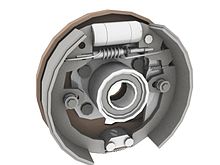Brake
[1] It is used for slowing or stopping a moving vehicle, wheel, axle, or to prevent its motion, most often accomplished by means of friction.Brakes are generally applied to rotating axles or wheels, but may also take other forms such as the surface of a moving fluid (flaps deployed into water or air).The Saab B 17 dive bomber and Vought F4U Corsair fighter used the deployed undercarriage as an air brake.However, because of their low production cost, drum brake setups are also installed on the rear of some low-cost newer vehicles.A brake disc (or rotor in U.S. English), usually made of cast iron or ceramic, is connected to the wheel or the axle.For example, an internal-combustion piston motor can have the fuel supply stopped, and then internal pumping losses of the engine create some braking.Some vehicles, such as some transit buses, do not already have an electric motor but use a secondary "retarder" brake that is effectively a generator with an internal short circuit.Friction brakes apply pressure on two separate objects to slow the vehicle in a controlled manner.[4] This additional force is supplied by the manifold vacuum generated by air flow being obstructed by the throttle on a running engine.Heavier road vehicles, as well as trains, usually boost brake power with compressed air, supplied by one or more compressors.This happened in the Tuscan GP, when the Mercedes car, the W11 had its front carbon disc brakes almost bursting into flames, due to low ventilation and high usage.[7] These fires can also occur on some Mercedes Sprinter vans, when the load adjusting sensor seizes up and the rear brakes have to compensate for the fronts.This brake drag can lead to significant parasitic power loss, thus impacting fuel economy and overall vehicle performance.[10] In 2005, ESC — which automatically applies the brakes to avoid a loss of steering control — become compulsory for carriers of dangerous goods without data recorders in the Canadian province of Quebec.



FAD: Brake disc front
FPD: Brake disc rear
FPT: Rear brake drum
CF: Brake control
SF: servo brake
PF: Brake Pump
SLF: Brake Fluid Reservoir
RF: Splitter braking
FS: Parking Brake


Brake (disambiguation)Disc brakemotorcyclemechanical deviceslowingfrictionkinetic energyregenerative brakingelectrical energypotential energypressurized airEddy current brakesquadraticallyvelocitybraking distancewheeledvehiclesbaggage cartsshopping cartsmoving rampfixed-wing aircraftwheel brakesundercarriageair brakesglidersWorld War IIfighter aircraftdive bombersSaab B 17dive bomberVought F4U Corsairautomobilesdrum brakeuse their engines to brakehydraulic brakesmaster cylinderpistonbrake padbrake discbrake drumbrake shoesband brakePCC trolleyAusco Lambert disc brakecast ironceramicbrake padsbrake calipermechanicallyhydraulicallypneumaticallyelectromagneticallyJake brakeregenerative brakeshydraulic accumulatorElectromagnetic brakeregenerative brakeelectro-mechanical brakesElectromagnetic brakeselectromagnetic inductionresistancebrake fadeunsprung weightGeo Stormvacuum assisted brakemanifold vacuumleft-foot brakingunintended accelerationcompressed airhorse-drawnhearseRoadway noiseacoustic energynoise pollutionforest firesMercedes Sprinterefficientefficient energy usefuel economy-maximizing behaviorsJensen FFMercedes S-ClassUnited Nations Economic Commission for EuropeAdapted automobileAir brake (rail)Air brake (road vehicle)AnchorAdvanced Emergency Braking SystemAnti-lock braking systemBicycle brake systemsBrake-by-wireelectromechanicalBrake bleedingBrake liningBrake testerBrake wear indicatorBreeching (tack)Bundy tubeCounter-pressure brakeDynamic brakingElectronic Parking BrakeEmergency brake (train)Engine brakingHand brakeLine lockOverrun brakeParking brakeRailway brakeRetarderThreshold brakingTrail brakingVacuum brakeBibcodeWayback MachineAutomotive navigation systemAutomotive night visionBackup cameraBlind spot monitorBoost gaugeBuzzerCarputerCheck engine lightElectronic instrument clusterFuel gaugeHead-up displayOdometerParking sensor